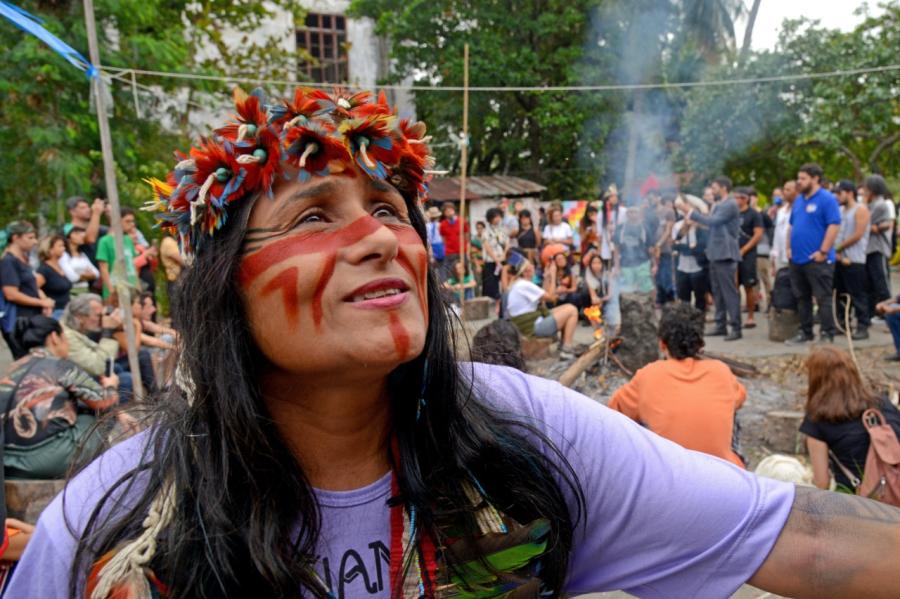The 1994 session of the United Nations Working Group on Indigenous Populations, like the year itself, may be a turning point for the international indigenous movement. It is a breathing space between a past in which indigenous issues were pushed onto the international agenda for the first time - a period which culminates with the International Year of the World's Indigenous People - and a future in which an institutional framework and a programme of action to improve the lives of indigenous peoples will be developed and brought into being. The year 1994 has been declared by the United Nations General Assembly as a preparatory phase for an International Decade which will open on 10 December 1994 and be concluded at the end of the year 2004.
Who could have predicted ten years ago that representatives of the Brazilian Yanomami - one of the least acculturated and most isolated peoples in the world - would fly from their village in northern Roraima state to the United Nations office in Geneva to bring news of the invasion of their territory by goldminers? And who would have thought that governments would voluntarily contribute to a fund to make such testimony possible?
For in 1988 a fund was opened to assist indigenous peoples with travel and expenses so that representatives from all communities could be assured. Since then the Voluntary Fund for Indigenous Populations has assisted more than 200 indigenous representatives from many different communities around the world.
Indigenous peoples have also had an influence on the Working Group's agenda and research activities. The Special Rapporteur, Miguel Alfonso Martinez, is preparing a study on treaties, agreements and other constructive agreements between indigenous peoples and States. The Chairperon and Rapporteur of the Working Group, Erica-Irene Daes, is drafting principles and guidelines for the protection of indigenous cultural and intellectual property. Both these issues were first raised by indigenous delegations.
Expert seminars have been held on racism, self-government and sustainable development. A further expert seminar is due to be held on land rights in early 1995. The expert seminars are organized to allow frank discussion, unfettered by national political considerations, about sensitive issues. Another feature of the expert seminars is the use of the local indigenous language as an official language of the meeting. Thus, in the meeting on self-government held in Nuuk, Greenland, simultaneous interpretation and documentation was available in Greenlandic. Mapudungum, the language used by the largest number of indigenous people in Chile, the Mapuche, was one of the official languages of the Santiago conference on sustainable development.
And what have been the achievements of the International Year? A cynic might answer: a lot of words and not a lot of money. This is only part of the story. There were a number of opportunities for indigenous people to address the member states of the United Nations directly. At the inauguration at UN Headquarters in New York, some 20 representatives addressed the General Assembly, and the Secretary-General announced that he had appointed Nobel Peace Prize Winner and indigenous activist Rigoberta Menchu Tum as Goodwill Ambassador for the Year. A month or so later, different leaders spoke at the Commission on Human Rights and, in June, another dozen representatives took the floor in the plenary of the World Conference on Human Rights in Vienna. Such access to the world's governments and the international press would have been unthinkable a decade ago.
Less than one million dollars in cash and kind was made available to the Coordinator of the International Year. Hardly enough to change the lives of the countless deprived indigenous communities in the world, but enough to support about ten percent of the over 300 projects submitted. Furthermore, many communities look to international cooperation as a means of improving their living conditions. In the upcoming Year, the development agencies within the United Nations system need to develop integrated programs specifically benefitting indigenous peoples.
The Decade opens up opportunities for indigenous peoples. So what are the challenges facing them over the next years?
There is a need to increase substantially the resources from the international community to improve their living conditions. This is, in a way, the pledge of the International Decade. Since many indigenous people live in strong and vibrant communities, the programs that are developed need to be integrated - bringing together developmental, environmental, cultural, human rights and other concerns - and should be indigenous-led. This will not be easy. Resources for all forms of development are limited and largely committed to other areas. International organizations are not always able to respond to the small-scale, community-based projects proposed by indigenous peoples. The challenge for the next years will be to persuade donor governments to dedicate more funds to indigenous development and the UN agencies to combine their expertise with the indigenous beneficiaries to plan and implement projects and programs together.
International meetings whose recommendations are likely to affect indigenous peoples will be held in the next few years. What will be the indigenous presence at the International Conference on Population and Development in Cairo in September 1994, at the Social Summit in Copenhagen in March 1995, and at the Fourth World Conference on Women in Beijing in September of the same year? Long excluded from international decision-making, indigenous peoples together with the NGO movement are now expecting their voices to be heard and respected.
Article copyright Cultural Survival, Inc.



